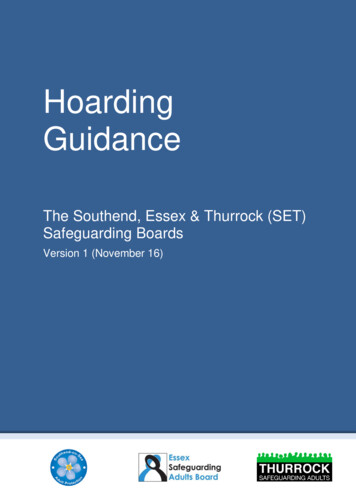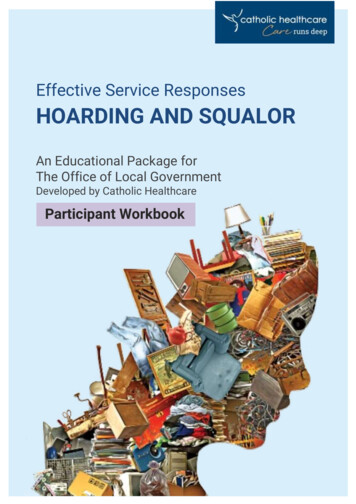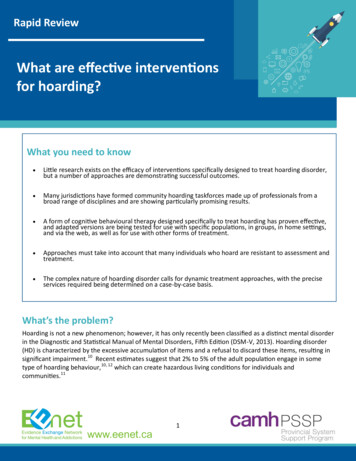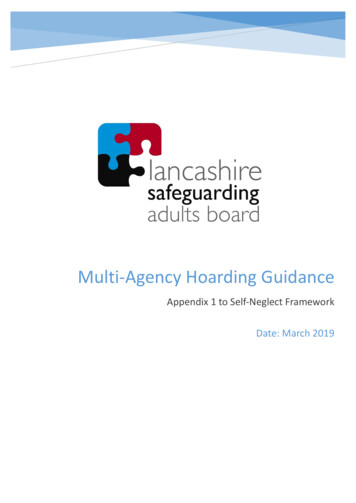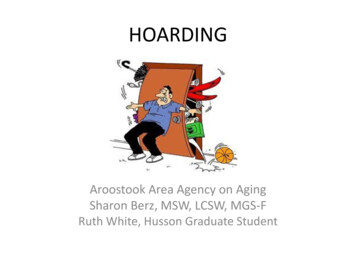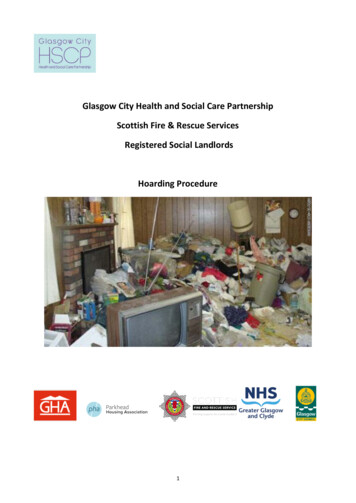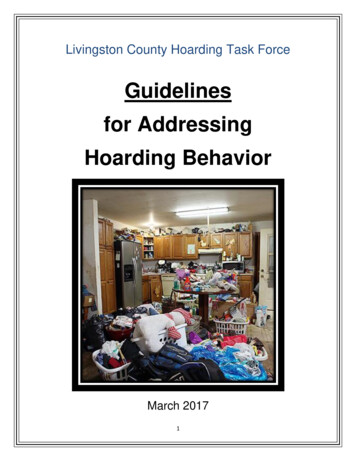
Transcription
Livingston County Hoarding Task ForceGuidelinesfor AddressingHoarding BehaviorMarch 20171
Table of ContentsI.General InformationPage 3a. What is Hoarding Behavior?Page 3b. How is it different from having too muchPage 4clutter or collectibles?c. What is animal Hoarding?Page 5d. Why is it a public safety issue?Page 6e. How can a concerned neighbor, friendPage 6or family member intervene?f. How do I know if it is Hoarding?Page 7II.Clutter/Hoarding ScalePage 8III.Self-Assessment - Hoarding Rating ScalePage 9IV.Hoarding Response Flow ChartPage 11V.How can I help?Page 12VI.Local ResourcesPage 132
General InformationWhat is Hoarding Behavior?According to the Mayo Clinic, Hoarding Disorder is a persistent difficulty discarding orparting with possessions because of a perceived need to save them. A person withhoarding disorder experiences distress at the thought of getting rid of the items.Excessive accumulation of items, regardless of actual value, occurs.Hoarding often creates such cramped living conditions that homes may be filled tocapacity, with only narrow pathways winding through stacks of clutter. Some peoplealso collect animals, keeping dozens or hundreds of pets in unsanitary conditionsbecause they can't care for them properly.Hoarding ranges from mild to severe. In some cases, hoarding may not have muchimpact on your life, while in other cases it seriously affects your functioning on a dailybasis.People with hoarding disorder often don't see it as a problem, making treatmentchallenging. But intensive treatment can help people with hoarding disorder understandtheir compulsions and live safer, more enjoyable lives3
How is it different from having too much clutter orcollectibles?In the homes of people who have hoarding disorder, the countertops, sinks, stoves,desks, stairways and virtually all other surfaces are usually stacked with stuff. And whenthere's no more room inside, the clutter may spread to the garage, vehicles and yard.Clutter and difficulty discarding things are usually the first signs and symptoms ofhoarding disorder, which often surfaces during the teenage years. As the person growsolder, he or she typically starts acquiring things for which there is no need or space. Bymiddle age, symptoms are often severe and may be harder to treat.Hoarding disorder affects emotions, thoughts and behavior. Signs and symptoms mayinclude: Persistent inability to part with any possession, regardless of its value Excessive attachment to possessions, including discomfort letting others touch orborrow them or distress at the idea of letting an item go Cluttered living spaces, making areas of the home unusable for the intendedpurpose, such as not being able to cook in the kitchen or use the bathroom to bathe Keeping stacks of newspapers, magazines or junk mail Letting food or trash build up to unusually excessive, unsanitary levels Acquiring unneeded or seemingly useless items, such as trash or napkins from arestaurant Difficulty managing daily activities because of procrastination and trouble makingdecisions Moving items from one pile to another, without discarding anything Difficulty organizing items, sometimes losing important items in the clutter4
Shame or embarrassment Limited or no social interactionsPeople with hoarding disorder typically save items because: They believe these items will be needed or have value in the future The items have important emotional significance — serving as a reminder of happiertimes or representing beloved people or pets They feel safer when surrounded by the things they saveHoarding disorder is different from collecting. People who have collections, such asstamps or model cars, deliberately search out specific items, categorize them andcarefully display their collections. Although collections can be large, they aren't usuallycluttered and they don't cause the distress and impairments that are part of hoardingdisorder.What is Animal Hoarding?People who hoard animals may collect dozens or even hundreds of pets. Animals maybe confined inside or outside. Because of the large numbers, these animals often aren'tcared for properly. The health and safety of the person and the animals are at risk dueto unsanitary conditions.As hard as it might be, you may also need to contact local authorities, such as police,fire, public health, child/adult protective services or animal welfare agencies, especiallywhen health or safety is in question.5
Why is it a public safety issue?Hoarding disorder can cause a variety of health concerns, including: Unsanitary conditions that pose a risk to health Increased risk of falls Injury or being trapped by shifting or falling items A fire hazard An inability to perform daily tasks, such as bathing or cooking Could encourage insects and/or rodents in the neighborhood Building code violations and/or structural damage Could cause sanitation or odor nuisances from garbage, trash and/or animal waste. Signal neglect of animals or peopleIn addition, people who hoard often have the following characteristics. Poor work performance Family conflicts Loneliness and social isolation Financial problems Legal issues, including evictionHow can a concerned neighbor, friend or family memberintervene?Hoarding behavior is a mental health issue and public health concern. Usually thebehavior has been occurring for a long time and requires patience and understanding.Frequently it requires the help of other people and agencies. Neglect or abuse issuesassociated with adults, children or animals may require emergency interventions. Codeviolations resulting from neglect or collections of materials may require emergencyactions. It is not recommended that family members or friends intervene without thecooperation of the hoarder, as this could lead to the development of dangerousbehaviors. If the person is willing to do a self-assessment, there is one located on pages 8and 9 of this document.6
You may also do an assessment by using the Clutter/Hoarding Scale located onpage 7 of this document.Once you have begun the discussion with the person, together you can begin toidentify some strategies for addressing the disorder.Not all Hoarding situations require emergency responseMost hoarding situations would benefit from the support of a professional.Please see the list on the last page of this document for possible professionalswho can assist with either the disorder or the clean-up process or both.See Animal Control Response to Hoarding Document for moreinformation.Contact Child Protective Services and Adult Protective Services ifthere is concerns for safety and /or neglect. See last page.How do I know if it is Hoarding?The National Study Group on Chronic Disorganization (NSGCD) has determined 5levels of the disorder.1. Hoarding Level One: Clutter is not excessive, all doors and stairways areaccessible, there are no odors, and the home is considered safe and sanitary.2. Hoarding Level Two: Clutter inhabits 2 or more rooms, light odors,overflowing garbage cans, light mildew in kitchens and bathrooms, one exit isblocked, some pet dander or pet waste puddles, and limited evidence ofhousekeeping.3. Hoarding Level Three: One bedroom or bathroom is unusable, excessivedust, heavily soiled food preparation areas, strong odors throughout the home,excessive amount of pets, and visible clutter outdoors.4. Hoarding Level Four: Sewer backup, hazardous electrical wiring, fleainfestation, rotting food on counters, lice on bedding, and pet damage to home.5. Hoarding Level Five: Rodent infestation, kitchen and bathroom unusable dueto clutter, human and animal feces, and disconnected electrical and/or waterservice7
8
Hoarding Rating ScalePlease use the following scale when answering items below:0 – no problem2 – mild problem, occasionally (less than weekly) acquires items notneeded, or acquires a few unneeded items4- moderate, regular (once or twice weekly) acquires items not needed, oracquires some unneeded items6 – severe, frequency (several times per week) acquires items not needed,or acquires many unneeded items8 – extreme, very often (daily) acquires items no needed, or acquires largenumbers of unneeded items1. Because of the clutter or number of possessions, how difficult is it for youto use the rooms in your home?01Not at icult2. To what extent do you have difficulty discarding (or recycling, selling,giving away) ordinary things that other people would get rid of?01Not at icult3. To what extent do you currently have a problem with collecting free thingsor buying more things than you need or can use or can afford?0None12Mild345Moderate6Severe978Extreme
4. To what extent do you experience emotional distress because of clutter,difficulty discarding or problems with buying or acquiring things?01None/Not at all23Mild45Moderate67Severe8Extremely5. To what extent do you experience impairment in your life (daily routine,job/school, social activities, family activities, financial difficulties) becauseof clutter, difficulty discarding, or problems with buying or acquiringthings?01None/Not at all2Mild345Moderate6Severe78ExtremelyCriteria for clinically significant Hoarding: (Tolin et al., 2008)A score of 4 or greater on questions 1 and 2, and a score of 4 or greater on eitherquestion 4 or question 5.References:Tolin DF, Frost RO, Steketee G, Gray KD, Fitch KE. (2008.) The economic and socialburden of compulsive hoarding. Psychiatry Research. 160:200–211.Tolin DF, Frost RO, Steketee G.(2010). a brief interview for assessing compulsivehoarding: The Hoarding Rating Scale-Interview. Psychiatry Research. 178:147–152.10
Suspicion of PotentialHoarding BehaviorIs there apossibility ofchild neglect orcruelty?Refer to ChildProtectiveServices855-444-3911Is there apossibility ofadult neglect orcruelty?Refer to AdultProtectiveServices855-444-3911Is there apossibility ofanimal neglector cruelty?Refer to AnimalControl517-548-9111Are thereaccumulations ofgarbage oranimal wastes? Isthere an odor?Are there insectsor rodents?Are therestructuralproblems, tallgrass, or nongarbageaccumulations?Refer to thePublic HealthRefer to Liv.County BuildingDepartment517-546-9850517-546-3240Are there firecode violationsin a buildingwith less thanthree residentialunits?Refer to thelocal FireDepartmentBrighton - 810-229-6640Fowlerville - 517-223-8561Green Oak - 810-231-1333Hamburg - 810-222-1100Hartland - 810-632-7676Are youready toclean up?See list ofprofessionals onthe last page11Howell - 517-546-0560Putnam - 734-878-6788Unadilla - 734-498-2551Are thereprobable mentalhealth issues?Refer toCommunityMental Health517-546-4126
How Can I help?Once it is determined that it is not an emergency situation (abuse, neglect, infestation,structural dangers), then there are a few things you can do to help. Talk with the person Use a gentle approach and let them share their story Respect the attachment to possessions by the person Remain calm and factual, but caring and supportive Evaluate for safety using the guidelines below Involve the person in seeking solutions, don’t force interventions Don’t be critical or judgmental about the environmentStart the discussion with Safety Codes: Help them establish 36 inch paths throughout their homes. This is standard forgetting a gurney into the residence. Also meets fire code. These paths must befrom doorways and windows. Use a tape measure and paint tape on the floor. Help them establish 24 inches from all ceilings. Tape measure and paint tapecan help with this as well Help them establish a 36 inch barrier around heating elements (water heater,stove, and refrigerator) and electrical lights. Help them establish a 24 inch square around every window. Floor to ceiling. Help them make sure they have working smoke detectors in each bedroom andon each floor of the home. Help them secure a portable fire extinguisher for each floor of the home Help to remove any combustible materials (paper, magazines, and flammables)from boiler rooms, mechanical rooms etc. Help to remove any gas or propane equipment or vehicles from inside the home(mopeds, lawn mowers, etc.)Connect them with resources:See the list of local resources on the next page.12
Local ResourcesSuspected Child Abuse/Neglect – 855-444-3911Suspected Adult Abuse/Neglect – 855-444-3911Suspected Animal Cruelty/Neglect – 517-546-9111Livingston County Hoarding Task Force Website -Force.aspxLivingston County Hoarding Task Force Facebook Page ionals to help with the disorder: Hoarders Anonymous - Terrance Daryl Shulman(JD,LMSW,ACSW,CAADC,CPC) at The Shulman Center – 248-3588508 Antonia Caretta (PhD.) – 248-553-9503 Diversified Counseling and Consulting Services in Howell – 517-4814085 Brighton Office Ann Arbor Consultation Services – 734-396-0219 Anxiety and OCD Treatment Center of Ann Arbor – 734-368-9691Professionals to help with the clean-up process: ServPro – (810) 220-3711 in Brighton Sharon McRill at Betty Brigade ( service@bettybrigade.com) or 734994-1000 Ron Brendahl at Caring Transitions (rbrendahl@caringtransitions.net)or 517-489-3827 Janet Kester (LMSW) at Hoarding Pros – 855-655-5800 Hoarder Help Services at hoarderhelpline.com or 855-791-3900 Address our Mess at 855-676-7848 or addressourmess.com13
Remember this Disorder takes time!Together we can help keep our lovedones safe!14
How do I know if it is Hoarding? II. Clutter/Hoarding Scale III. Self-Assessment - Hoarding Rating Scale IV. Hoarding Response Flow Chart V. How can I help? VI. Local Resources Page 3 Page 3 Page 4 Page 5 Page 6 Page 6 Page 7 Page 8 Page 9 Page 11 Page 12 Page 13 . 3

